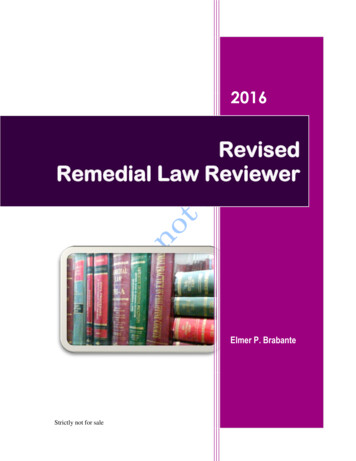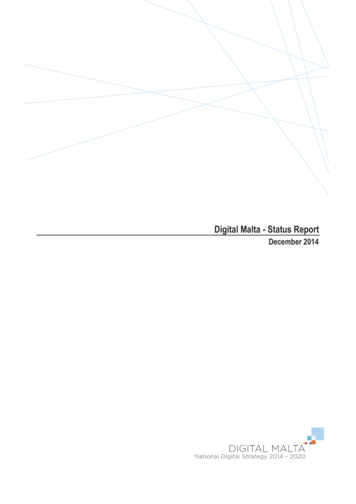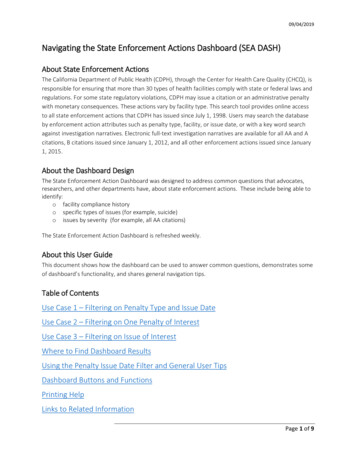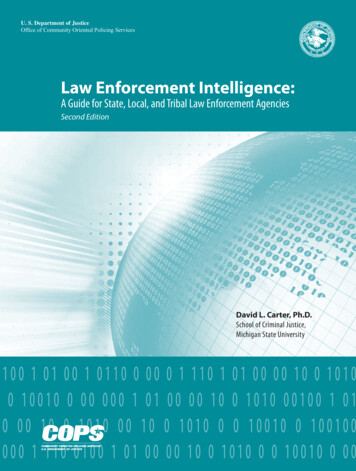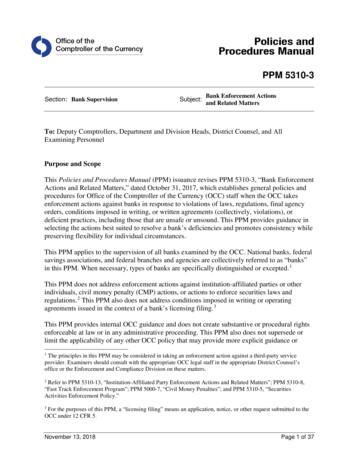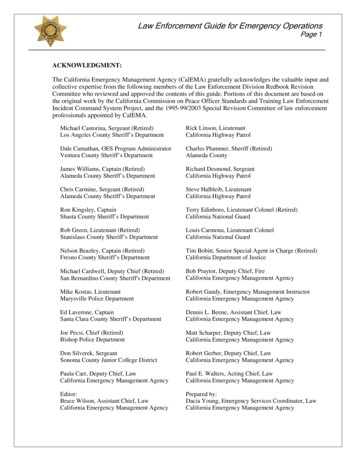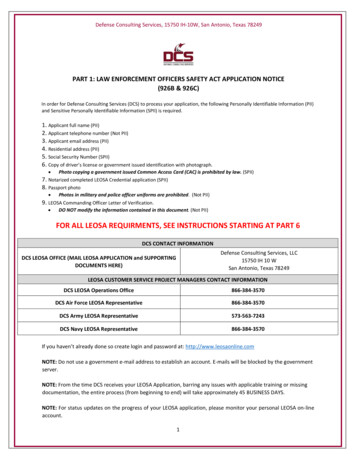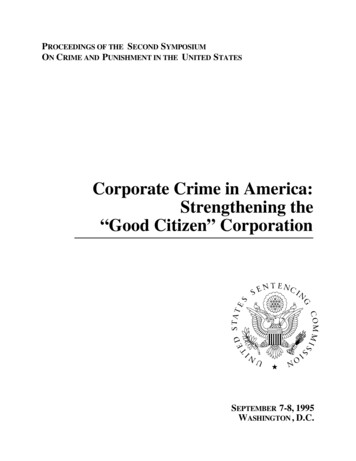
Transcription
Antidumping and Countervailing Duty EnforcementActions and Compliance Initiatives: FY 2017Fiscal Year 2018 Report to CongressU.S. Customs and Border Protection
i
ii
Executive SummaryCBP is committed to ensuring that AD/CVD laws are vigorously enforced. To this end, CBP hasestablished key partnerships with U.S. Immigration and Customs Enforcement (ICE), U.S.Department of Commerce (Commerce), U.S. Department of the Treasury, Office of the U.S.Trade Representative (USTR), and other partner agencies to provide comprehensiveenforcement. With these effective collaborations in place, CBP has had success in identifying,penalizing, and disrupting efforts to evade the payment of AD/CVD.In FY 2017, CBP levied 43 monetary penalties totaling over 253.6 million on importers forfraud, gross negligence, and negligence for AD/CVD violations under 19 U.S.C. § 1592; carriedout 38,567 reviews of potential AD/CVD violations and identified over 24 million indiscrepancies; and conducted 94 audits and audit surveys of importers that identified 27 millionin AD/CVD discrepancies with 1.7 million collected (as of October 2017). CBP is continuingto pursue collections of all unpaid duties. Although CBP does not seize for revenue violations,CBP assisted ICE in 30 seizure incidents with a domestic value of more than 48.8 millioninvolving violations of AD/CVD.In total, as of September 30, 2017, CBP was enforcing 411 AD/CVD orders. During FY 2017,Commerce issued 57 new AD/CVD orders and initiated 73 new AD/CVD investigations.Additionally, during the first quarter of FY 2018, Commerce issued 1 new AD/CVD order andinitiated 17 new AD/CVD investigations.CBP is meeting the demands of increasing new AD/CVD orders by implementing refinedAD/CVD targeting. CBP is prioritizing targeting on high-risk imports and exploring ways tomake its targeting more efficient and effective. This will help ensure that CBP optimizes itsresources toward reviewing high-risk imports and facilitating legitimate imports.The future of AD/CVD enforcement will continue to rely on key partnerships, specifically withICE and Commerce, to identify patterns of noncompliance and to collaborate on enforcementcases. Partnerships within the trade community are also critical to identify unfair tradingpractices. The trade community provides market intelligence and commodity expertise toidentify unfair trading practices or illegal trading activity. CBP’s 10 Centers of Excellence andExpertise (Centers) have a strong focus on commodity-based AD/CVD orders. The Centers arecentralizing AD/CVD functions for the industries and importers covered by their respectiveCenter. The Centers are helping to increase uniformity and expertise across CBP foradministration of AD/CVD entries and enforcement. As described in this report, these initiativesunderpin CBP’s commitment to target the evasion of AD/CVD, protect the revenue of the U.S.Government, and ensure a level playing field for U.S. industry.The collection of outstanding AD/CVD and enforcement actions relating to AD/CVD mattersremains a complex enforcement challenge. CBP and partner agencies are working closelytogether to address collection and related bonding issues. CBP has identified options for riskbased bonding as part of its implementation of Section 115 of the Trade Facilitation and TradeEnforcement Act (TFTEA) (Pub. L. 114-125). Consistent with legal requirements, in FY 2017,iii
CBP continued to require additional security in the form of a Single Transaction Bond to protectthe revenue when CBP had reasonable evidence of a risk of revenue loss. These measures havebeen very effective in protecting the revenue and facilitating compliance with AD/CVD. CBPalso pursues administrative or judicial processes to maximize the collection of AD/CVD.iv
Antidumping and Countervailing Duty EnforcementActions and Compliance Initiatives: FY 2017Table of ContentsI.Legislative Language . 1II. Background on CBP’s AD/CVD Enforcement . 2A. Enforcing AD/CVD Laws to Address Evasion . 2B. Enforcement Partnerships . 41.Trade Partnerships . 52.Government Partnerships . 63.International Partnerships . 6A.B.C.1.2.D.Enforcement Results . 7Legal Enforcement . 8AD/CVD Entry Administration . 9ACE AD/CVD Functionality . 10Entry Administration Workload . 10Trade Transformation . 10III. AD/CVD Collections . 13A. Uncollected AD/CVD . 13B. Debt Collection Process . 15C. Measures to Increase Collections. 16D. Import Value, Cash Deposit, and Liquidation Amount Information . 17E. Information on Non-Collected AD/CVD Amounts by Order and Fiscal Year . 17F. FY 2017 CDSOA Clearing Account Balance and Disbursement Report . 18IV. Conclusion . 19V. Appendices . 20Appendix A. FY 2017 Imports with Antidumping or Countervailing Cases . 20v
Appendix B.Appendix C.Appendix D.Appendix E.Appendix F.FY 2017 Liquidations of Antidumping and Countervailing . 32Open Bills by Case Number and Fiscal Year . 43CDSOA Clearing Account Balances as of October 1, 2017* . 60FY 2017 CDSOA Disbursement Information . 66List of Acronyms . 70vi
I.Legislative LanguageThis report has been compiled pursuant to the language set forth in Senate Report 114-68accompanying the Fiscal Year (FY) 2016 Consolidated Appropriations Act (P.L. 114-113) andSection 691(a) of the North American Free Trade Agreement Implementation Act (P.L. 103182).Senate Report 114-68 states:The Committee directs CBP to continue submitting the following reports required inSenate Report 112–169 accompanying Public Law 113–6, including the same level ofdetail prescribed in such report and during the timelines prescribed for each report:AD/CVD Actions and Compliance Initiatives, AD/CVD Liquidation Instructions,AD/CVD Collection of Outstanding Claims (consistent with Public Law 103–182), andAD/CVD Collection New Shipper Single Entry Bonds. A version of each report shall beposted on CBP's Web site.Section 691(a) of P.L. 103-182 states:(a) ANTIDUMPING AND COUNTERVAILING DUTY COLLECTIONS. – TheCommissioner of Customs shall before the 60th day of each fiscal year after fiscalyear 1994 submit to Congress a report regarding the collection during the precedingfiscal year of duties imposed under the antidumping and countervailing duty laws.1
II. Background on CBP’s AD/CVD EnforcementU.S. Customs and Border Protection (CBP) has a statutory responsibility to enforce the customsand trade laws of the United States and collect customs duties due the U.S. Government resultingfrom the importation of goods into the United States, including Antidumping and CountervailingDuties (AD/CVD). CBP has specifically designated AD/CVD enforcement as a Priority TradeIssue (PTI). PTIs are high-risk areas that can cause significant revenue loss, hurt the U.S.economy, or threaten the health and safety of the American people. The AD/CVD trade programwas elevated to PTI status within CBP in Fiscal Year (FY) 2003 to ensure that a concerted,systematic approach was implemented to facilitate legitimate trade, detect and deter evasion ofthe AD/CVD laws, and liquidate transactions in a timely and accurate manner.CBP is committed to ensuring that AD/CVD laws are enforced vigorously, and takes an agencywide approach to AD/CVD enforcement. CBP collaborates with ICE to substantiate and actupon allegations of duty evasion and to support enforcement actions. CBP also partners withCommerce on a wide range of AD/CVD issues related to enforcement responsibilities. CBP’sagency wide coordination and partnerships with other government agencies are essential to itsenforcement of AD/CVD laws.In FY 2017, there were imports of approximately 2.39 trillion in goods into the U.S., anddeposits of approximately 34.6 billion in duties to the U.S. Department of Treasury (Treasury).Of the 2.39 trillion in goods imported in FY 2017, approximately 13.3 billion (0.55 percent)were subject to an AD/CVD order. Importers deposited approximately 1.5 billion in AD/CVD,which represents approximately 4.33 percent of the total duties collected in FY 2017.A.Enforcing AD/CVD Laws to Address EvasionCBP takes allegations of evasion very seriously, and employs all available methods inaccordance with AD/CVD laws to address these matters. The increasing complexity of thestrategies employed by parties attempting to evade these laws is a constant challenge.CBP identifies potential evasion by working with U.S. industry, ICE, Commerce, other U.S.Government agencies, and our international partners, including the Canada Border ServicesAgency (CBSA) and Mexico’s Servicio de Administracion Tributaria (SAT), to develop newsources of information. CBP also takes a comprehensive and integrated view of security andtrade enforcement, pursues all available avenues to identify and penalize efforts to evadeAD/CVD, and explores new and innovative tools to protect U.S. revenue.CBP and ICE have had success in identifying, penalizing, and disrupting efforts to evade thepayment of AD/CVD. In FY 2017, CBP levied 43 monetary penalties totaling over 253.6million on importers for fraud, gross negligence, and negligence for AD/CVD violations under19 U.S.C. § 1592, up from 13 penalties in FY 2016. These penalties covered importers ofAD/CVD commodities such as aluminum extrusions and wooden bedroom furniture. CBP isemphasizing penalties for trade violations to make it significantly more expensive for2
noncompliant importations compared to compliant importations. CBP assisted ICE in 30 seizureincidents with a domestic value of more than 48.8 million involving violations of AD/CVD.To target AD/CVD evasion, CBP utilizes significant national assets from across the agency toenforce AD/CVD laws. CBP employs many tools including import trade trend and valuationanalysis, the use of targeted reviews and audits to address high-risk cases, lab testing, and specialoperations. CBP targets individual importers and uses industry-wide approaches to detect anddeter AD/CVD evasion. For example, CBP conducts AD/CVD audits of individual importers,and conducts audit surveys to cover multiple importers of individual AD/CVD commodities.These AD/CVD audit surveys measure the risk of a sector of AD/CVD imports, determine thesuitability of full audits, and provide informed compliance for future imports. In all, CBPcompleted 94 audits and audit surveys, and 66 assignments were still in progress at the end of FY2017, of importers of AD/CVD commodities. These commodities included aluminumextrusions, chlorinated isocyanurates, citric acid, diamond saw blades, frozen shrimp, glycine,lightweight thermal paper, multilayered wood flooring, mushrooms, PET film, pneumatic tires,polyethylene retail carrier bags, solar cells, steel, steel wire garment hangers, and woodenbedroom furniture, just to name a few. These audits identified 27 million in AD/CVDdiscrepancies with 1.75 million collected, as of October 2017. CBP is continuing to pursuecollections of all unpaid duties.CBP continues to protect the revenue in cases of suspected AD/CVD evasion by employing itslegal authority to require additional security in the form of a Single Transaction Bond (STB) onAD/CVD imports when CBP has a reasonable basis to conclude that a risk of loss to the revenueexists. In cases of AD/CVD evasion and noncompliance (and other identified financial risks),these measures have been very effective in protecting the revenue and facilitating compliancewith AD/CVD orders.For example, in FY 2017, CBP requested STBs from an importer of Chinese garlic subject toantidumping duties, due to the risk to the revenue presented by its imports. CBP receivedinformation from Commerce indicating a potential significant final antidumping duty liability,and CBP requested additional security in the form of STBs to protect against the risk that those finalantidumping duties would go unpaid. The importer filed an action in the Court of InternationalTrade (CIT) seeking to enjoin CBP from requiring the STBs as a condition of release of itsimported garlic. The CIT denied the importer’s request for injunctive relief, citing to CBP’sbroad authority to request additional bonding where the agency had a reasonable basis toconclude that the STBs were necessary to protect the revenue and ensure the enforcement ofapplicable laws.CBP Laboratories and Scientific Services (LSS) played a key supporting role in CBP’s AD/CVDevasion efforts. In FY 2017, LSS issued 429 laboratory reports involving 829 samples of articlessuspected to have AD/CVD violations. The commodities analyzed included honey, garlic,monosodium glutamate, polyethylene retail carrier bags, polyethylene terephthalate film,isocyanurates, steel coil, steel plate, steel pipe, line pipe, steel nails, steel tubing, non-orientedelectrical steel, steel wire hangers, steel threaded rods, stainless steel wire rod, stainless steel bar,cast iron pipe fittings, iron castings, porcelain-on-steel cooking ware, magnesium andmagnesium forms, aluminum oxide, petroleum wax candles, aluminum extrusions, aluminumtubing, copper tubing, multilayered wood flooring, tissue paper, coated paper, uncoated paper,3
supercalendered paper, solar cells and panels, hand tools, ball bearings, polyvinyl alcohol,polyester staple fiber, woven ribbons, and artist canvases.In FY 2016, the signing of the Trade Facilitation and Trade Enforcement Act (TFTEA), Pub. L.114-125, brought into force the Enforce and Protect Act (EAPA). EAPA established formalprocedures for submitting and investigating allegations against importers as to evasion ofAD/CVD orders. EAPA required CBP to establish a new Trade Remedy Law Enforcementdivision. CBP has done so by standing up the Trade Remedy Law Enforcement Directorate(TRLED) within the Office of Trade (OT). This directorate is charged with overseeing theEAPA investigations and establishing an Evasion National Targeting Analysis Group (NTAG) toprevent and counter evasion, as well as assisting in the EAPA investigations.During FY 2017, TRLED issued notices for 16 EAPA cases indicating that the agency hadinitiated an investigation or taken interim measures to protect the revenue during the course of aninvestigation. Several of the notices were issued up to a month ahead of the statutory deadline.Each of these notices are available on the EAPA page of the CBP website.1 By taking interimmeasures in the form of requiring cash deposits or additional bonding, CBP prevented theevasion of approximately 45 million of AD/CVD annually.These EAPA investigations involved commodities such as diamond sawblades, oil countrytubular goods (OCTG), refrigerants, glycine, wire hangers, and wooden bedroom furniture. InFY 2017, TRLED also issued a final determination in its first EAPA investigation, whichconcerned the transshipment of wire hangers from China through Thailand. CBP concluded thatthere was substantial evidence that merchandise covered by the AD/CVD order was entered intothe customs territory of the United States through evasion. This EAPA investigation, as well as aseparate investigation into the transshipment of wire hangers through Malaysia, have providedsignificant trade remedy returns to the U.S. wire hanger industry. ICE has worked closely withCBP to facilitate EAPA investigations utilizing both ICE domestic and international offices togather timely and relevant information critical to completing these inquiries.CBP also targets AD/CVD evasion based on confidential allegations received from industry andpartner government agencies outside of the EAPA context. In FY 2017, CBP received 71additional allegations of evasion and noncompliance with AD/CVD orders. These allegationswere primarily provided to CBP through CBP’s e-Allegations online trade violations reportingsystem available at https://apps.cbp.gov/eallegations. CBP corresponds with every party thatprovides its contact information to review the allegation with the alleger and obtain additionalinformation about the allegation. CBP reviews and researches every allegation submittedthrough e-Allegations to determine the validity of the allegations as to the trade law violations.Some alleged violations are reviewed and resolved internally within CBP, and some are referredto ICE for further investigation.B.1Enforcement ement/tftea/enforce-and-protect-act-eapa.4
1.Trade PartnershipsU.S. industry is an invaluable partner in AD/CVD enforcement. CBP has effective workingrelationships with many U.S. industries and meets regularly with U.S. industry representatives todiscuss AD/CVD evasion schemes. CBP’s AD/CVD enforcement is more successful when it isconducted in partnership with U.S. industry, trade associations, and importers. The tradecommunity provides critical insight to CBP on what is happening in the United States andinternational marketplace, and their perspectives help CBP interpret the vast amount of trade dataavailable to CBP. The trade can help CBP identify unusual trading patterns, high-risk exportersand importers, and new products in the marketplace, and supplement CBP’s own analyses ofhigh-risk imports. They also provide CBP with technical commodity information. By workingwith the trade community, CBP deepens its understanding of the way business and industryoperate in the ever-changing global marketplace and leverages that information for risk analysisand targeting.CBP takes a proactive approach to AD/CVD enforcement, and works with industry to helpprepare CBP to enforce new AD/CVD orders. During the preliminary phases of Commerce’sAD/CVD investigations, CBP meets with industry representatives to obtain market informationand commodity expertise, and CBP provides technical advice to make the measures moreenforceable. During FY 2017, CBP held in-depth discussions with industry representatives toprepare to enforce AD/CVD on numerous commodities.After AD/CVD orders are issued, CBP works with U.S. industry to provide training necessary toenforce the orders. The U.S. industry provides national webinars to train CBP field staff onproduct information, market trends, and indications of AD/CVD evasion. CBP also regularlymeets with trade representatives on an ongoing basis about specific AD/CVD evasion issues.In all, in FY 2017, CBP held over 27 outreach engagements with U.S. manufacturers, importers,and other members of the trade community, including three national webinars, 17 meetings, 2U.S. manufacturer facility visits, and five national steel industry seminars at various ports ofentry. These outreach efforts provide CBP with AD/CVD commodity information and marketintelligence to enforce AD/CVD orders issued by Commerce. Commerce and ICE participatedin many of these meetings and trainings, including the steel seminars.CBP continues to meet regularly with the AD/CVD Working Group of the Commercial CustomsOperations Advisory Committee (COAC) to solicit advice and develop new initiatives withregard to CBP’s enforcement and collection of AD/CVD. In FY 2017, in collaboration with theCOAC and Commerce Department, CBP posted on CBP.gov new technical guidance forimporters on AD/CVD case statuses listed in the Automated Commercial Environment (ACE)AD/CVD case management portal. As part of CBP’s extensive collaboration with the tradecommunity, CBP is also improving its transparency on its AD/CVD evasion enforcement efforts.In FY 2017, CBP continued to post AD/CVD updates on CBP.gov to provide updates on itsAD/CVD enforcement efforts. CBP continues to seek ways to increase transparency that areconsistent with the Trade Secrets Act, Privacy Act, and other relevant legislation.5
2.Government PartnershipsSenate Report 112-169, as referenced by Senate Report 114-68, directs CBP to work withCommerce, Treasury, Office of the U.S. Trade Representative (USTR), and all other relevantagencies to increase collections. In accordance with this requirement, CBP closely collaborateswith ICE at all levels to develop and coordinate civil and criminal enforcement of the AD/CVDlaws. CBP and ICE have opened joint Trade Enforcement Coordination Centers in Atlanta,Georgia; Baltimore, Maryland; Buffalo, New York; Chicago, Illinois; Detroit, Michigan; ElPaso, Texas; Houston, Texas; Los Angeles, California; New Orleans, Louisiana; New York,New York; Nogales, Arizona; Norfolk, Virginia; and San Juan, Puerto Rico, which supportholistic enforcement in AD/CVD cases.Another invaluable partner in AD/CVD enforcement is Commerce, which is responsible foradministering the AD/CVD laws and establishing the duty amounts CBP collects from importers.CBP and Commerce share extensive information on AD/CVD. On a continuing basis,Commerce refers to CBP the allegations of fraud or evasion it receives from the public, inaddition to evidence it uncovers during the conduct of its own AD/CVD proceedings.Commerce assists CBP in identifying potential audit candidates on the basis of informationreceived in the context of its AD/CVD proceedings. Commerce further supports CBP’s efforts atcountering evasion by reviewing, upon request, information obtained during CBP audits andidentifying discrepancies or claims that contradict information on Commerce’s record of theunderlying proceeding. Commerce also regularly provides training and webinars to CBP oncomplex AD/CVD orders. In FY 2017, Commerce staff participated in, and provided extensiveinput on, COAC’s AD/CVD working group, CBP/ICE AD/CVD commercial fraud training, andsteel industry seminars.CBP holds biweekly meetings at the working level and quarterly meetings at the executive levelwith Commerce to coordinate AD/CVD-related administration and enforcement activities. ICEalso participates in the joint working level meetings with Commerce; further, in addition to theregular interaction through ACE, CBP’s AD/CVD Policy Branch and Commerce’s CustomsLiaison Unit are in daily contact through e-mail or phone calls. This coordination helps tofacilitate CBP’s AD/CVD entry, liquidation, and collection processes on numerous case-specificissues throughout the year. CBP also meets, as needed, with Commerce, Treasury, and USTR toconfer on AD/CVD issues.3.International PartnershipsCBP is working with its international partners to increase steel enforcement cooperation in NorthAmerica. In FY 2017, CBP engaged with Canada Border Services Agency (CBSA) andMexico’s Servicio de Administracion Tributaria (SAT) by increasing dialogue and exploringopportunities to collaborate on AD/CVD steel enforcement. The North American customsagencies participated in a customs steel dialogue in Washington, DC on June 6, 2017, anddeveloped an AD/CVD collaborative work plan to carry out their first trilateral AD/CVD steeloperations. The goal is to enhance the steel enforcement abilities of the three North Americancustoms agencies.6
III. Enforcement and Entry AdministrationA.Enforcement ResultsCBP’s AD/CVD targeting efforts, led by the AD/CVD NTAG in Miami, Florida, achievednotable results in FY 2017. Examples of CBP’s successes from targeting in AD/CVDenforcement in FY 2017 by the NTAG, ports of entry, and Centers of Excellence and Expertise(Centers) include: Aluminum Extrusions: CBP recovered over 860,000 on importations, which wereimported with an incorrect tariff classification and without the required payment ofAD/CVD;Artist Canvas: Ongoing operations– 1.13 million in lost revenue collected as ofSeptember 30, 2017;Corrosion-Resistant Steel: CBP’s reviews of imports of corrosion-resistant steel resultedin the collection of over 200,000 in antidumping duties;Curtain Wall Units (aluminum extrusions): As the result of a CBP audit, CBP imposed apenalty on an importer for over 200 million for failure to declare AD/CVD on importssubject to the AD/CVD orders on aluminum extrusions from China;Nails: 3.5 million in lost revenue was collected for failure to declare AD/CVD;Solar Panels: CBP conducted several enforcement operations on imports of solar panelsfrom China and Taiwan and identified or recovered a total of 44.9 million in revenue;Steel Pipe: CBP stopped the importation of steel pipe from China that had been illegallytransshipped through Vietnam, and prevented the loss of over 480,000 in antidumpingduties (ADD);Tapered Roller Bearings (TRB): Operation TRB targeted and examined entries subject toAD/CVD and resulted in revenue of over 125,000;Wire Garment Hangers: CBP’s Operation Hanging It Up examined 37 entries, whichhave been rated advanced for approximately 1.3 million in AD/CVD; and,Xanthan Gum: 344,584 in ADD has been recovered.The examples listed in this section highlight just a few of the operations that are routinelyconducted by CBP personnel. These efforts reflect the continued dedication of CBP to target theevasion of AD/CVD laws, protect the revenue of the U.S. Government, and ensure a levelplaying field for U.S. industry. CBP is continuing to pursue collections of all unpaid duties andpenalties.7
B.Legal EnforcementCBP’s Office of Chief Counsel (OCC), through the Associate Chief Counsel for Trade andFinance, the Associate Chief Counsel for Enforcement and Operations, and Associate ChiefCounsel field offices, continues its vigorous engagement in both administrative and judicialactions related to the collection of outstanding AD/CVD and enforcement actions for customslaw violations relating to AD/CVD matters.In FY 2017, OCC attorneys, under the leadership of the Associate Chief Counsel forEnforcement and Operations, provided legal advice and training on enforcement optionsavailable to address customs violations, including circumvention of AD/CVD laws.Enforcement and Operations attorneys provided comprehensive legal assistance relating to CBPactions taken pursuant to EAPA (19 U.S.C. § 1517) to investigate allegations of evasion ofAD/CVD. In addition, Enforcement and Operations attorneys provided legal advice relating toenforcement of the trade laws and enforcement actions undertaken pursuant to various statutes,including 19 U.S.C. § 1592 and the False Claims Act (31 U.S.C. § 3729), that contribute toAD/CVD enforcement. Successful enforcement actions deter unlawful behavior and result inrevenue recovery. For example, in FY 2017, the Government reached a settlement againstImport Merchandising Concepts L.P. and two individuals to resolve allegations ofmisclassification of merchandise to evade antidumping duties on wooden bedroom furnitureimported from the People’s Republic of China.In FY 2017, attorneys under the leadership of the Associate Chief Counsel for Trade and Financecontinued carrying out OCC’s strategic approach to AD/CVD collections litigation, whichinvolves trying lead cases that will control outcomes in numerous other matters and pursuinginterest in excess of bond amounts to deter future nonpayment by sureties. Throughout FY 2017,Trade and Finance attorneys were involved in ongoing litigation in 30 AD/CVD collection casesfiled by CBP in the CIT, over 340 AD/CVD refund cases filed against CBP in the CIT, actionsseeking to enjoin CBP from requiring security at the time of entry, numerous importerbankruptcies, and several state-level surety insolvency proceedings, together representing over 450 million in AD/CVD at stake. In the cases that resulted in decisions during FY 2017, CBPcontinued its string of victories to enforce and collect AD/CVD. For example: In Harmoni Int’l Spice Inc. v. United States, the CIT upheld CBP’s request for additionalbonding to secure potential antidumping duty liability on entries of garlic. 211 F. Supp. 3d1298 (Ct. Int’l Trade 2017);Later in the year, the Court of Appeals for the Federal Circuit affirmed the CIT’s decisionthat a delinquent surety owed subs
CBP and ICE have had success in identifying, penalizing, and disrupting efforts to evade the payment of AD/CVD. In FY 2017, CBP levied 43 monetary penalties totaling over 253.6 million on importers for fraud, gross negligence, and negligence for AD/CVD violations under 19 U.S.C. § 1592, up from 13 penalties in FY 2016.
